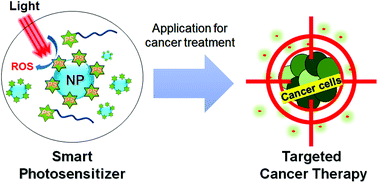当前位置:
X-MOL 学术
›
Biomater. Sci.
›
论文详情
Our official English website, www.x-mol.net, welcomes your
feedback! (Note: you will need to create a separate account there.)
Advanced smart-photosensitizers for more effective cancer treatment
Biomaterials Science ( IF 5.8 ) Pub Date : 2017-11-01 00:00:00 , DOI: 10.1039/c7bm00872d Wooram Park 1, 2, 3, 4, 5 , Soojeong Cho 1, 2, 3, 4, 5 , Jieun Han 6, 7, 8, 9, 10 , Heejun Shin 6, 7, 8, 9, 10 , Kun Na 6, 7, 8, 9, 10 , Byeongdu Lee 5, 11, 12, 13 , Dong-Hyun Kim 1, 2, 3, 4, 5
Biomaterials Science ( IF 5.8 ) Pub Date : 2017-11-01 00:00:00 , DOI: 10.1039/c7bm00872d Wooram Park 1, 2, 3, 4, 5 , Soojeong Cho 1, 2, 3, 4, 5 , Jieun Han 6, 7, 8, 9, 10 , Heejun Shin 6, 7, 8, 9, 10 , Kun Na 6, 7, 8, 9, 10 , Byeongdu Lee 5, 11, 12, 13 , Dong-Hyun Kim 1, 2, 3, 4, 5
Affiliation

|
Photodynamic therapy (PDT) based upon the use of light and photosensitizers (PSs) has been used as a novel treatment approach for a variety of tumors. It, however, has several major limitations in the clinic: poor water solubility, long-term phototoxicity, low tumor targeting efficacy, and limited light penetration. With advances in nanotechnology, materials science, and clinical interventional imaging procedures, various smart-PSs have been developed for improving their cancer-therapeutic efficacy while reducing the adverse effects. Here, we briefly review state-of-the-art smart-PSs and discuss the future directions of PDT technology.
中文翻译:

先进的智能光敏剂,可更有效地治疗癌症
基于光和光敏剂(PSs)的光动力疗法(PDT)已被用作针对多种肿瘤的新型治疗方法。但是,它在临床上有几个主要局限性:水溶性差,长期光毒性,靶向肿瘤的功效低以及光穿透性有限。随着纳米技术,材料科学和临床介入成像程序的发展,已经开发了各种智能PS,以改善其癌症治疗效果并减少不良影响。在这里,我们简要回顾了最新的智能PS,并讨论了PDT技术的未来发展方向。
更新日期:2017-11-16
中文翻译:

先进的智能光敏剂,可更有效地治疗癌症
基于光和光敏剂(PSs)的光动力疗法(PDT)已被用作针对多种肿瘤的新型治疗方法。但是,它在临床上有几个主要局限性:水溶性差,长期光毒性,靶向肿瘤的功效低以及光穿透性有限。随着纳米技术,材料科学和临床介入成像程序的发展,已经开发了各种智能PS,以改善其癌症治疗效果并减少不良影响。在这里,我们简要回顾了最新的智能PS,并讨论了PDT技术的未来发展方向。











































 京公网安备 11010802027423号
京公网安备 11010802027423号